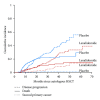Secondary primary malignancies in multiple myeloma: an old NEMESIS revisited
- PMID: 22851973
- PMCID: PMC3407607
- DOI: 10.1155/2012/801495
Secondary primary malignancies in multiple myeloma: an old NEMESIS revisited
Abstract
The treatment of myeloma has undergone extraordinary improvements in the past half century. These advances have been accompanied by a concern for secondary primary malignancies (SPMs). It has been known for decades that extended therapy with alkylating chemotherapy agents, such as melphalan, carries an increased risk of therapy-related myelodysplastic syndrome and/or acute myeloid leukemia (t-MDS/AML), with a cumulative risk as high as 10-15%. High-dose chemotherapy with autologous stem cell support became widely accepted for myeloma in the 1990s. Despite the use of high doses of melphalan, the risk of t-MDS/AML with this procedure is estimated to be less than 5%, with much of this risk attributable to pretransplant therapy. Recently, lenalidomide has come under scrutiny for its possible association with SPMs. It is too soon to declare a causal relationship at this time, but there appears to be an increased number of SPMs in reports from several studies using lenalidomide maintenance. Current studies should be amended and future studies planned to better define the risk of SPMs and the risk factors and mechanisms for its development. Patients should be educated regarding this potential concern but the current use of lenalidomide should not generally be altered until further data are available.
Figures

References
-
- Curtis RE, Freedman DM, Ron E, et al. NIH Publication. 05-5302. Bethesda, Md, USA: National Cancer Institute; 2006 . New malignancies among cancer survivors: SEER cancer registries, 1973–2000.
-
- Olivanen T. Acute leukaemia and other secondary neoplasms in patients treated with conventional chemotherapy for multiple myeloma: a Finnish Leukaemia Group study. European Journal of Haematology. 2000;65(2):123–127. - PubMed
-
- Bergsagel DE, Sprague CC, Austin C, Griffith KM. Evaluation of new chemotherapeutic agents in the treatment of multiple myeloma—IV. L-Phenylalanine mustard (NSC-8806) Cancer Chemotherapy Reports. Part 1. 1962;21:87–99. - PubMed
-
- Hoogstraten B, Sheehe PR, Cuttner J, et al. Melphalan in multiple myeloma. Blood. 1967;30(1):74–83. - PubMed
LinkOut - more resources
Full Text Sources
Research Materials
Miscellaneous

